


 The
First International Tournament on the Alps
The
First International Tournament on the Alps
Glorious chess, glorious mountains!
Livigno, a pretty Alpine town at 1,816m altitude, was host to the first ‘Livigno Open’ – the ‘highest’ chess tournament in Europe. Players, divided in three groups: A, B and C, were treated to a delightful welcome, 9,000 Euro prize fund and prestigious gifts and generous hampers with local produce donated by the sponsors.
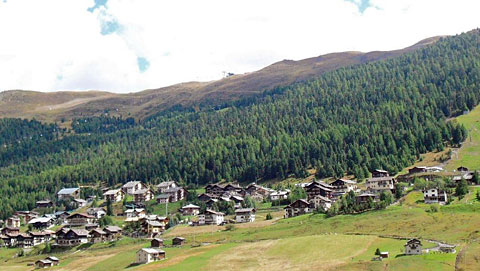
A panorama of Livigno, which is spread in long line alongside the hills
Livigno, a small town of 6000 inhabitants, was founded by settlers during the Middle Ages. It is located in the province of Sondrio, in the region of Lombardy. Administratively it belongs to Valtellina, a picturesque region in the most northern part of the Italian Alps. Nestled in a beautiful green valley, encircled with mountains its economy is based on tourism, both in winter and summer. It enjoys a tax exemption status, which makes it particularly attractive for shoppers of high quality duty-free goods. Until the 1970s it was a farming village, but nowadays Livigno enjoys a better economic situation and a higher number of inhabitants. It has recently recorded one of Italy's highest birth rates (19.4 per 1000 inhabitants). Building companies, craft industry and agriculture are somewhat developed, but all these sectors are in various ways linked to the main source of income. |
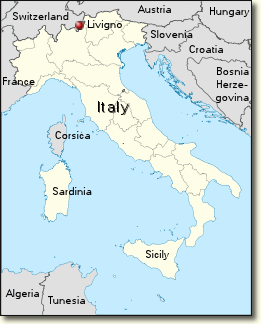
|
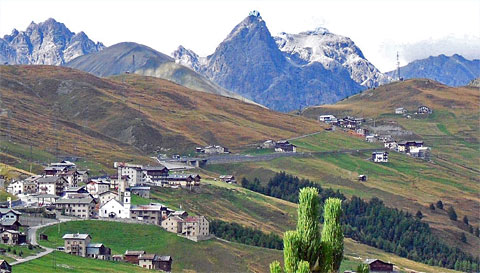
The Livigno Range is part of the Central Eastern Alps. Livigno can be reached from passages that are controlled by mountain custom check-points both from eastern Switzerland and Northern Italy.
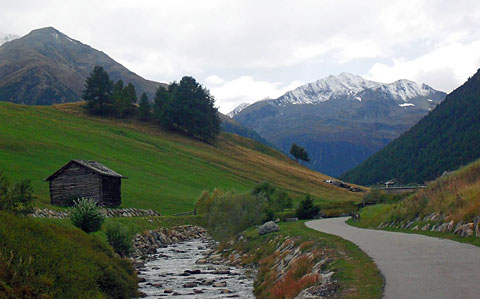
A common scene of beauty in Livigno. A walk along this brook towards the
playing
venue makes for a relaxing, refreshed mind before a chess game.
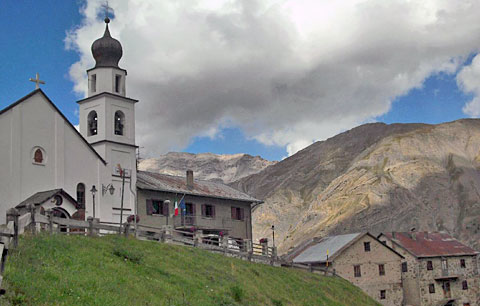
Trepalle, Europe’s highest parish
In the municipality of Livigno is found Trepalle – the highest inhabited village in Europe which stands tall at 2069 m. The parish church Santa Anna (on the photo) and its priest Don Camillo are the subject of the acclaimed literary work ‘The Little World of Don Camillo’ by Giovannino Guareschi. It is a satirical take, with a lot of humor, on the political divide between the church and the Communist party in the postwar Italy. Don Camillo has been immortalized in the cinema and in a television series by the famous French comedian Fernandel.

Diana Mihajlova making friends in Livigno [photo: Adriano Pedrana]
The locals reminded me that Livigno’s cows are more beautiful and produce a better cheese than those from France or Switzerland. About 1000 cows of the breed ‘Brown Swiss’ provide an important agricultural revenue, which is a core of the alpine life and culture.
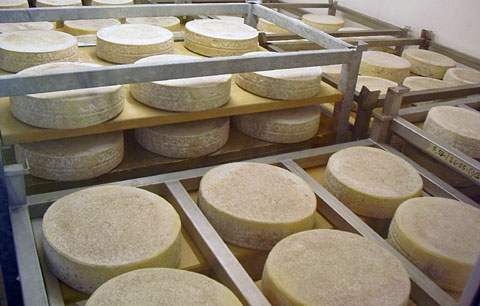
The local milk products factory – ‘La Latteria’ – produces a special Livigno cheese and various other milk products. Perched on a hill just on the outskirts of Livigno it offers daily fresh produce to be sampled on a large, sunny terrace surrounded with mountains.
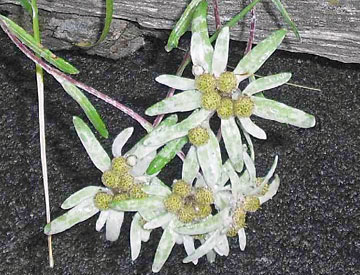
The edelweiss is a famous alpine flower. It belongs to the sunflower family and it is a protected plant in many mountainous countries. Edelweiss means (in German) ‘noble whiteness’ and is considered a symbol of purity. Its leaves and flowers are covered with white fluff, which makes the plant adaptable to high altitudes and protects it from cold, aridity and UV radiation. Italians have given it a well becoming name: ‘stella alpina’ – alpine star.

The Alpine marmot is a largest rodent among the squirrel species. Excellent diggers they build their very elaborate dwellings in the earth where they hide when in danger and spend up to nine months per year in hibernation. However, during the tournament they were well awake and active and having built a little colony close by the playing venue provided a delightful entertainment for the curious visitors.
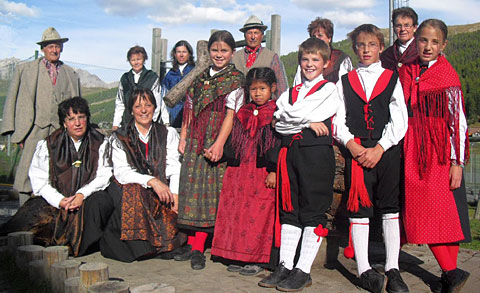
Various generations of the beautiful people from Livigno clad in their folk
dresses
came to welcome the foreign and Italian chess players at the opening ceremony

The Town Hall bears a sign that does not look Italian – ‘Bait Dal Comun’ is a dialect of the Lombard variety largely used by the Livigno population. It belongs to the Rhaeto-Romance languages originated from the provincial Latin of the central Alps. A dictionary of the ‘Livìgn’dialect is currently being compiled by local and foreign linguists lead by the Livigno’s librarian Dr Emanuele Mambretti.

Local boys Matteo and Roberto have a special mission: to collect a ‘marriage
tax’
On a Sunday afternoon, amid the horns of a jolly wedding car procession these charming lads told me about a custom in their community: whoever wants to marry a Livigno girl has to pay a ‘marriage tax’. On the day of the marriage, a group of young village men approaches the groom to demand his due. It is a sum of money that is used for the community benefits like to repair the church bell or provide toys for the local kindergarten. On rare occasions, a hapless groom dares to avoid the ‘tax’. Then the young defenders of their female folk see to it that he is vilified and ostracized all his life to the point that he would deeply regret his unwise decision. That is how it is done in Livigno!
A small group of chess enthusiast, members of the small Livigno chess club put together their forces, organisational abilities and love for the noble game and with the help of the town’s municipality mounted a very successful chess tournament to the great satisfaction of players that came from as far afield as Israel and Peru.
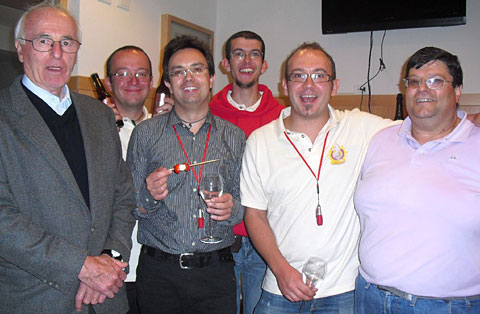
Members of Livigno Chess Club and organisers of the First Livigno Open:
Dr Gian Battista
Ceresa, Adriano Pedrana, Giuseppe Cusini, Dario Pedrana and Lino Castellani
(local MP)
Among the organisers on the photo above there is one medical doctor, a local Member of Parliament, an engineer and three tourist agents. Along with promoting chess, they had another goal at the same time: they were hoping that Caissa would look favourably on them and make their beautiful town and region better known to the outside world. Whenever they would say that they came from Livigno, the ignorant foreigners would need further geographical explanations and the crestfallen Livignasques would humbly recur to their more famous neighbour 20 km away on the Swiss side of the Alps and mutter: it is close to St. Moritz. Fed up by such injustice – Livigno is more beautiful than St Moritz! – they decided to right the wrongs with the help of an international chess tournament.
The enthusiasm about their town was definitely shared by the participants at the First Livigno Open. About the tournament itself, the chess players agreed that it has been one of the best they have attended. Among them were:
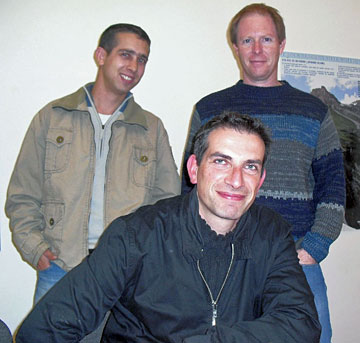
Yair Yudkovsky (2315), Udi Weisbuch (2306, seated), and FM Ehud Shachar
(2353) from Israel

Yohan Trens (2086) and IM Maxime Aguettaz (2412) from France
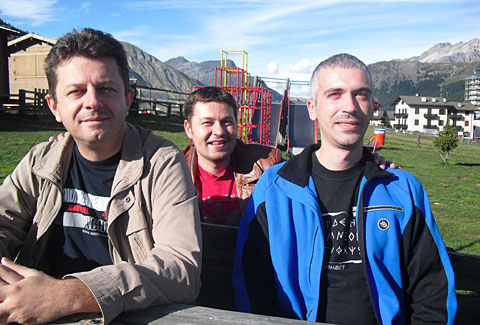
GM Miroljub Lazic (2502), FM Mladen Milenkovic (2406) and Goran Urosevic
from Serbia

FM Martin Skliba (CZE, 2287), Filip Umanec (CZE, 2206), IM Peter Michalik
(SVK, 2455) and IM Marian Kantorik (SVK, 2379)
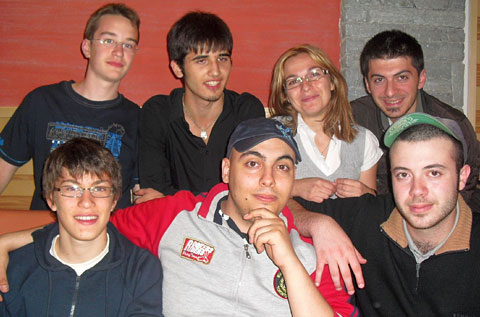
Marco Codenotti (2175), FM Andrea Stella (2334), WFM Maria Tereza Arnetta (2111), FM Francesco Bentivegna (2360); (from left, front row) FM Alessio Valsecchi, FM Angelo Damia (2287) and FM Alessandro Bove are some of the emerging young Italian players.
Maria Teresa comes from Sicily where she teaches chess full-time. She told me that Sicilian schoolchildren are among the most numerous in Italy that take seriously to chess.

Among the youngest were Andrea (11) and Francesco (13) Simoncini. They are both gifted kids with special interest in music. Andrea plays flute and Francesco the piano. To my surprise, I have learned from their parents that they were autodidact in both music and chess. Andrea is also an aspiring mathematician – he came second in the world mathematical competition ‘International Mathematical Kangaroo’.
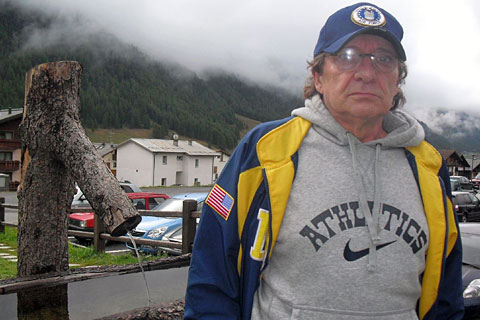
Posing by the village fountain constructed in a natural tree trunk is the most senior in the tournament, Domenico Rizzi who showed the C group participants how chess is played. He won the first place (7/8). Recently, Domenico decided to play regularly at chess tournaments and never went lower than third place even in higher B group competitions.

GM Emilio Cordova from Peru (2539) shared third in the Open A but won the blitz tournament (7/7) that was organized only for a number of the higher rated participants. He was awarded a hand-crafted chess set whose glass pieces were filled with grappa. Emilio plays for Peru but lives in Matanzas, Cuba. Immediately after the tournament, he was on his way to Khanty-Mansiysk to play on the second board for Peru. Next year he would like to correct one only omission in this tournament: he would bring over his Cuban girlfriend, WIM Yanira Vigoa Apecheche.

This exquisite chess set is hand made in a limited edition. The blown glass pieces are filled with light and dark grappa (a grape-based brandy), a gift from one of the sponsors, the distillery Mazzetti.

The winners: IM Petar Arnaudov (BUL, 2442) second; GM Igor Naumkin (RUS, 2483) first; GM Arkadij Rotstein (GER, 2542) third. Apart from the cash prizes (1st – 1000 euro), the winners also received luxury watches in the price range of 2000 Euro, donated by the sponsor, the Swiss jewellery and watch makers Baume & Mercier.
| # | Sd | Ti. | Name | Rtng | Perf | Pts. | Buc1 | BucT | ARO |
| 1 | 6 | GM | Naumkin Igor | 2483 | 2691 | 7.5 | 43.50 | 47.00 | 2418.11 |
| 2 | 8 | IM | Arnaudov G. Petar | 2442 | 2634 | 7.0 | 45.50 | 49.00 | 2413.56 |
| 3 | 2 | GM | Rotstein Arkadij | 2542 | 2501 | 6.0 | 46.00 | 49.50 | 2376.00 |
| 4 | 3 | GM | Cordova Emilio | 2539 | 2489 | 6.0 | 43.50 | 47.00 | 2364.33 |
| 5 | 21 | -- | Yudkovsky Yair | 2315 | 2486 | 6.0 | 43.00 | 44.50 | 2360.56 |
| 6 | 7 | IM | Michalik Peter | 2455 | 2459 | 5.5 | 46.50 | 51.00 | 2379.00 |
| 7 | 18 | FM | Shachar Ehud | 2353 | 2498 | 5.5 | 42.50 | 46.00 | 2417.89 |
| 8 | 19 | FM | Stella Andrea | 2334 | 2402 | 5.5 | 41.00 | 44.00 | 2321.89 |
| 9 | 9 | IM | Aguettaz Maxime | 2412 | 2360 | 5.5 | 38.50 | 41.50 | 2280.44 |
| 10 | 4 | GM | Petkov Vladimir | 2513 | 2361 | 5.5 | 38.00 | 41.50 | 2281.11 |
| 11 | 32 | -- | Codenotti Marco | 2175 | 2334 | 5.5 | 35.50 | 38.50 | 2253.67 |
| 12 | 29 | FM | Karl Hans | 2211 | 2319 | 5.5 | 34.50 | 37.50 | 2268.67 |
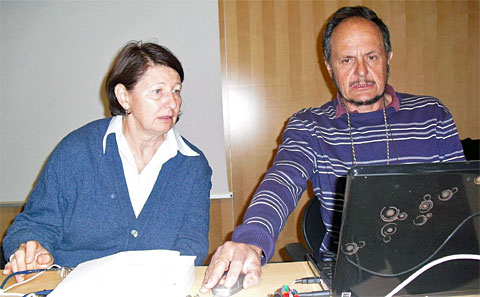
The arbiters: Franca Dapiran and Marco Santandrea
The IA Franca Dapiran is a rating officer within the Italian Chess Federation and has long experience arbitrating at International tournaments, world matches and Olympiads. Among her colleagues she is known as ‘the only arbiter that Kasparov is scared of’, due to an amusing episode at the Turin Olympiad where after a scuffle with the former world champion who did not obey her orders to keep silent, she marched him out of the playing hall.

Ezio Montalbini provided more than thirty electronic chess boards and monitored the games on-line. Ezio is behind the organization of many tournaments within Italy. He is also a sponsor/organiser of the prestigious (Cat. XVIII) New Year tournament in Reggio Emilia which this year will have competing Ivanchuk, Caruana, Morozevich, Short, Movsesian, Navara, Gashimov, Vallejo Pons, Onischuk and Godena.

Adriano Pedrana and Adolivio Capece
Among the supporters was Adolivio Capece, an international relations officer within the Italian Chess Federation. Adolivio is also editor of the chess magazine ‘L’Italia Scacchistica’ (‘Chess Italy’), which this year celebrates 100 years of existence. It is the second oldest chess publication, after the British Chess Magazine. He has written several books on chess, the latest being ‘Chess in the History and in the Arts’ – a large, hard cover volume that chronicles chess throughout the history giving many examples of chess found in the visual arts, anecdotes, legends and other curiosities related to chess.
Adriano Pedrana, a polyglot, a local journalist and leader of their tourist agency was a driving force behind the organisation of the tournament. Together with his associates, they kept running around wondering: ‘Is everything all right? We hope players would tell if there is something we need to improve.’
They should not worry. The 1st International Livigno Open run impeccably smoothly. And it was only the first time. Next year is bound to be bigger and better. See you in Livigno in 2011!